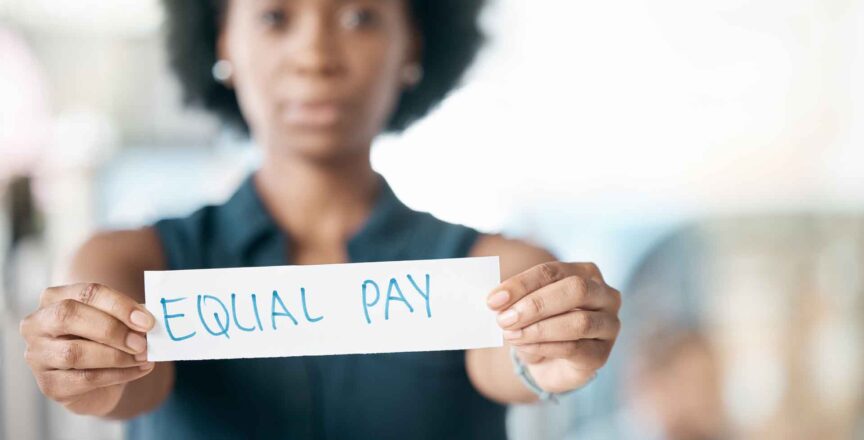

The wage gap is the unfair difference between what men and women earn for the same work. It affects all women, but especially Black women, who make only 58 cents for every dollar a white man makes.
This gap costs Black women almost a million dollars over their careers and reflects the racism and sexism they face at work.
But you can fight back. In this blog post, you will learn:
- Why the wage gap exists and how it impacts Black women
- How to deal with pay-gap gaslighting and ask for what you deserve
- How employers and allies can support equal pay and diversity
- How policy changes can help close the gap and create a fairer workplace
Ready to take action? Let’s dive in!
Understanding the Wage Gap
The wage gap is a complex issue with many contributing factors. It’s like a puzzle with many pieces, and we need to look at each piece to see the whole picture. So, let’s dive in!
What is the Wage Gap?
The wage gap is the difference in earnings between different groups of people. It’s often measured by comparing the median annual earnings of full-time, year-round workers. For example, if we compare the earnings of men and women, we find that women typically earn less than men. This is known as the gender wage gap.
But the wage gap doesn’t affect all women equally. When we look at the data, we see that Black women face a larger wage gap than white women. According to the U.S. Census data, the average Black woman makes only 58 cents for every dollar earned by a white man. That’s a significant difference!
Why Does the Wage Gap Exist?
There are many reasons why the wage gap exists. Some of these include:
- Discrimination: Despite laws against it, discrimination still occurs in hiring, promotions, and pay decisions.
- Occupational segregation: Women and people of color are often concentrated in lower-paying jobs.
- Workplace policies: Policies around parental leave, flexible work hours, and childcare can impact women’s earnings.
The Impact of the Wage Gap
The wage gap has serious consequences for Black women and their families. It affects their economic security, health, and well-being. It also contributes to wealth disparities between different racial and ethnic groups.
For example, let’s say a Black woman and a white man both start working at age 20. If they both work until they’re 60 and the wage gap remains unchanged, the Black woman would earn $964,400 less than the white man over her career.
That’s almost a million dollars! Imagine what she could do with that money – pay off student loans, buy a house, start a business, or even retire early.
But it’s not just about money. The wage gap also affects Black women’s opportunities for advancement and leadership positions. It can limit their ability to advocate for themselves and their communities.
So, as you can see, the wage gap is not just an abstract concept or a statistic. It’s a real issue that affects real people every day.
The Daily Experience of Black Women in the Workplace
Let’s take a closer look at what it’s like to be a Black woman in the workplace. It’s not all doom and gloom, but it’s not a walk in the park either.
Common Challenges Faced by Black Women at Work
Black women face a unique set of challenges in the workplace. These include:
- Microaggressions: These are subtle, often unintentional, acts of racism or sexism. They can be as simple as a backhanded compliment or as complex as being overlooked for a promotion because of your race or gender.
- Gaslighting: This is when someone manipulates you into questioning your own reality. In the context of the wage gap, it could be an employer denying that there is a pay disparity or blaming you for earning less.
- Discrimination: Despite laws against it, discrimination is still a reality for many Black women in the workplace. It can take many forms, from overt acts of racism to subtle biases in hiring and promotion decisions.
The Impact of Microaggressions and Gaslighting
Microaggressions and gaslighting can have a significant impact on Black women’s mental health and job satisfaction. They can lead to feelings of isolation, self-doubt, and frustration.
They can also contribute to the wage gap by making it harder for Black women to advocate for themselves and negotiate for higher pay.
Personal Stories and Experiences
To illustrate these challenges, let’s consider the story of Tasha, a Black woman working in tech.
Despite having the same qualifications and experience as her white male colleagues, Tasha is often overlooked for promotions and leadership opportunities.
She also faces microaggressions on a daily basis, such as being mistaken for an administrative assistant or being told that she’s “articulate” (as if that’s surprising!).
When she raises concerns about these issues, her employer dismisses them or blames her for not being “assertive” enough.
Tasha’s story is not unique. Many Black women have similar experiences in the workplace. But by sharing these stories and raising awareness about these issues, we can start to make a difference.
Navigating Pay-Gap Gaslighting
Now that we’ve painted a picture of the challenges Black women face in the workplace, let’s talk about how to navigate one of these challenges: pay-gap gaslighting. It’s like navigating a maze, but don’t worry, we’ve got a map!
What is Pay-Gap Gaslighting?
Pay-gap gaslighting is when someone, often an employer or colleague, denies the existence of the wage gap or blames you for earning less.
It’s like being told that the sky is green when you know it’s blue. It can make you question your reality and undermine your confidence.
Strategies for Navigating Pay-Gap Gaslighting
Here are some strategies to help you navigate pay-gap gaslighting:
- Educate Yourself: Knowledge is power. Learn about the wage gap and its causes. Use credible sources like U.S. Census data to back up your claims.
- Trust Your Experience: If you feel like you’re being paid less than your counterparts, trust your gut. Your experience is valid.
- Seek Support: Connect with others who have similar experiences. There’s strength in numbers.
- Speak Up: If you feel comfortable, address the issue directly with your employer or HR department.
Self-Advocacy and Negotiation
One of the most effective ways to address the wage gap is through self-advocacy and negotiation. Here are some tips:
- Do Your Research: Find out what others in similar roles and industries are earning.
- Practice Your Pitch: Prepare what you’re going to say and practice it with a friend or mentor.
- Be Assertive: Clearly state your needs and expectations.
- Stay Positive: Keep the conversation focused on your value and contributions.
Remember, negotiation is a skill that can be learned and improved over time. So don’t be discouraged if you don’t get it right the first time. Keep trying, keep learning, and keep advocating for yourself!
The Role of Employers in Addressing the Wage Gap
Employers play a crucial role in addressing the wage gap. After all, they’re the ones signing the paychecks! But it’s not just about doing the right thing – it’s also good for business.
Why Employers Should Care About the Wage Gap
Addressing the wage gap can benefit employers in several ways:
- Diversity and Inclusion: A diverse workforce brings a variety of perspectives and ideas, which can lead to better decision-making and problem-solving.
- Employee Satisfaction and Retention: Employees who feel valued and treated fairly are more likely to be satisfied with their jobs and stay with the company longer.
- Reputation: Companies that take steps to address the wage gap can enhance their reputation as socially responsible employers.
Steps Employers Can Take
Here are some steps employers can take to ensure equal pay:
- Conduct a Pay Equity Audit: This involves analyzing employee compensation data to identify any pay disparities.
- Implement Transparent Pay Policies: This includes sharing salary ranges for positions and explaining how pay decisions are made.
- Provide Training and Development Opportunities: This can help all employees, including Black women, advance in their careers.
Promoting Diversity and Inclusion
Employers should promote diversity and inclusion. This means valuing all employees and their contributions. They can do this by having policies like flexible work arrangements, parental leave, and anti-discrimination training.
So, employers, if you’re reading this, remember: addressing the wage gap is not just good for your employees – it’s good for your business too!
Conclusion on Wage Gap
We’ve taken a deep dive into the wage gap affecting Black women at work, and it’s clear that this is a complex issue with no easy solutions. But that doesn’t mean we should throw in the towel. Far from it!
We’ve seen how Black women can navigate pay-gap gaslighting and advocate for themselves. We’ve explored the crucial role of employers in ensuring equal pay and promoting diversity and inclusion. We’ve discussed how allies can support Black women in their fight for wage equality. And we’ve looked at how policy changes can help close the gap.
But remember, addressing the wage gap isn’t just about policies and strategies. It’s about changing attitudes and challenging biases. It’s about creating a workplace culture that values all employees and their contributions. And most importantly, it’s about standing up for fairness and equality.
So whether you’re a Black woman affected by the wage gap, an employer looking to make a difference, or an ally wanting to support, remember: every step counts. Every action matters. And together, we can close the wage gap.
Now, let’s get to work!
FAQs
What is the difference between the wage gap and the earnings gap?
The wage gap compares the hourly wages of different groups of workers, while the earnings gap compares the annual income of different groups of workers.
Both measures show that Black women earn less than white men, but the earnings gap is larger because it also reflects factors such as hours worked, unemployment, and labor force participation.
How does education affect the wage gap?
Education can help reduce the wage gap, but it cannot eliminate it. Black women with higher levels of education still earn less than white men with the same or lower levels of education.
For example, according to U.S. Census data, a Black woman with a bachelor’s degree earns 70 cents for every dollar a white man with a bachelor’s degree earns.
What are some solutions to close the wage gap?
There is no single solution to close the wage gap, but rather a combination of actions that can be taken by individuals, employers, allies, and policy makers. Some of these actions include:
- Negotiating for fair pay and advocating for oneself
- Ensuring equal pay and promoting diversity and inclusion in the workplace
- Supporting policies that address the causes and effects of the wage gap
- Educating others about the wage gap and its impact on Black women
Last modified: October 16, 2023



